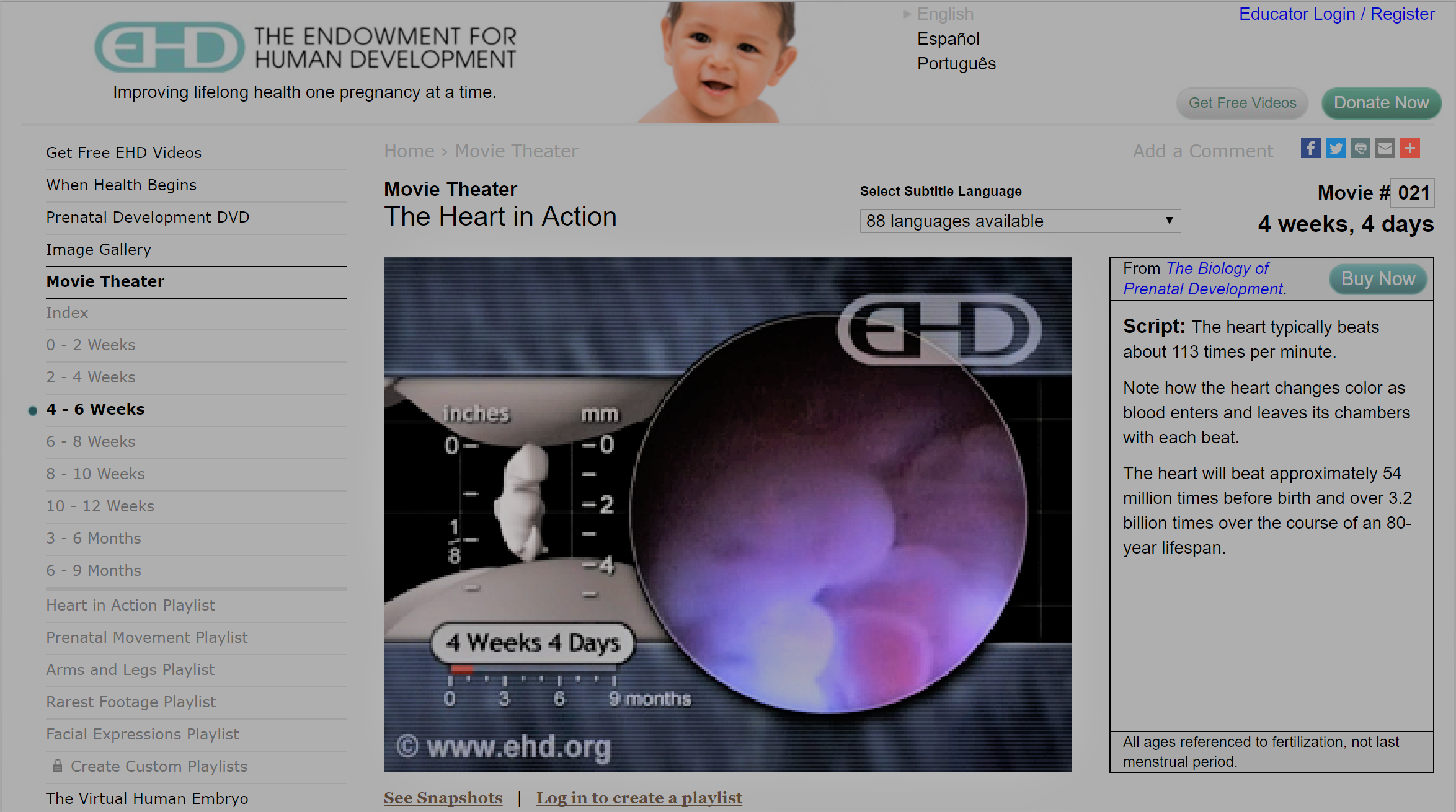Links: Embryologists / Pro-Choice Philosophers / Embryoscopy Video / Research / Visualization
What Is the Unborn, Biologically Speaking?
Opinions OF Embryologists
Embryo (2013) - Maurice T. Wagner
Click here for photo of a 6-week embryo (by Lennart Nilsson) in the Photographic Timeline of Prenatal Development at Abort73.com.
"Human development begins at fertilization when a sperm fuses with an oocyte to form a single cell, the zygote. This highly specialized, totipotent cell (capable of giving rise to any cell type) marks the beginning of each of us as a unique individual." Keith L. Moore, T.V.N. Persaud and Mark G. Torchia, The Developing Human: Clinically Oriented Embryology, 11th ed. (Elsevier Inc. 2020), pg. 11
"Although life is a continuous process, fertilization (which, incidentally, is not a "moment") is a critical landmark because, under ordinary circumstances, a new, genetically distinct human organism is formed when the chromosomes of the male and female pronuclei blend in the oocyte." -- Ronan O'Rahilly and Fabiola Müller, Human Embryology & Teratology, 3rd ed. (New York: Wiley-Liss, 2001), p. 8
“Zygote. This cell, formed by the union of an oocyte and a sperm, is the beginning of a new human being (i.e., an embryo).” -- Keith L. Moore and T.V.N. Persaud, Before We Are Born: Essentials of Embryology and Birth Defects, Sixth Edition (Philadelphia: Saunders, 2003), p. 2
“Development begins with fertilization, the process by which the male gamete, the sperm, and the female gamete, the oocyte, unite to give rise to a zygote.” -- T.W. Sadler, Langman’s Embryology, 9th Edition (London: Lippincott Williams & Wilkins, 2004), p. 3
SEE THE UNBORN IN LIVING COLOR
We heartily recommend the amazing rare footage the Endowment for Human Development (EHD) has made readily available in the video above and through its apps and website. Click here or on the link below to view more of EHD’s free content. We strongly encourage you to donate to EHD to show your support for their model of offering free content.
Note that EHD has created great apps for many common mobile devices that allow you to watch (and show others to whom you're talking) videos of the unborn at many stages of development. JFA highly recommends using these apps and donating to EHD to help EHD continue providing this excellent free, life-saving content.
To find the apps on an iOS device, click the link above or below. Or, search "Endowment Human Development" This should bring up the See Baby Pregnancy Guide (LMP age) and My Baby Pregnancy Guide (Fertilization Age).
New Research Relevant to This Topic
From the Abstract: "Using human embryos and human pluripotent stem cells, we show that the reorganization of the embryonic lineage is mediated by cellular polarization leading to cavity formation. Together, our results indicate that the critical remodelling events at this stage of human development are embryo-autonomous, highlighting the remarkable and unanticipated self-organizing properties of human embryos.
From the Abstract: "Here we report the use of a novel in vitro system to study the post-implantation development of the human embryo. We unveil the self-organizing abilities and autonomy of in vitro attached human embryos. We find human-specific molecular signatures of early cell lineage, timing, and architecture."
Food for THought: Biology Textbook
“Traditional ways of classifying catalog animals according to their adult structure. But, as J. T. Bonner (1965) pointed out, this is a very artificial method, because what we consider an individual is usually just a brief slice of its life cycle. When we consider a dog, for instance, we usually picture an adult. But the dog is a ‘dog’ from the moment of fertilization of a dog egg by a dog sperm. It remains a dog even as a senescent dying hound. Therefore, the dog is actually the entire life cycle of the animal, from fertilization through death.” Gilbert SF. Developmental Biology. 6th edition. Sunderland (MA): Sinauer Associates; 2000. (Chapter 2, Life cycles and the evolution of developmental patterns.)
Source Information for Images used in JFA Brochures and Exhibits
Unless otherwise noted, images of the embryos, fetuses, and newborn infant are from Lennart Nilsson & Lars Hamberger, A Child Is Born (New York: Delacorte Press/Seymour Lawrence, 1990)
Images of older humans (toddler and above) are stock photos or privately-held photos.
All images of the unborn (fetal development and abortion) are dated from fertilization.
Approximate size measurements refer to "greatest length" except for fertilization (diameter). See Ronan O'Rahilly & Fabiola Muller, Human Embryology & Teratology, 3rd ed. (New York: Wiley-Liss, 2001), p. 492
Images of the results of abortion from the Center for Bioethical Reform.
Thank you to the Center for Bio-Ethical Reform (CBR) for providing the abortion images found on JFA’s Exhibits and Brochures. (Link Warning: While we recommend CBR's website, please be aware that it contains graphic video footage of abortion in progress on its homepage.) See CBR's "Verifying Photograph Authenticity" page for authentication of the photos on the JFA Exhibit (2000).
Developmental Milestones Referenced in JFA Brochures and Exhibits: Sources And Explanations
"Where Do You Draw the Line?" (click image for detail). See other JFA Exhibits here.
At fertilization, the unborn has a "unique and complete human genome"
See Ronan O'Rahilly & Fabiola Muller, Human Embryology & Teratology, 3rd ed. (New York: Wiley-Liss, 2001), p. 8: “Although life is a continuous process, fertilization (which, incidentally, is not a "moment") is a critical landmark because, under ordinary circumstances, a new, genetically distinct human organism is formed when the chromosomes of the male and female pronuclei blend in the oocyte.”
Note that none of the following developmental milestones are unique to human beings. Can any of these be the ground then for human rights? If any of these is the ground for human rights, do certain animals also deserve human rights? If none of these is the ground for human rights, what is?
4-week embryo has a "heart rate of 113 beats per minute"
See the Endowment for Human Development's "The Beat Goes On"
7-week embryo "swallows, hiccups, moves arms and legs"
18-week fetus "responds to sound"
See Hepper PG, Shahidullah BS. "Development of fetal hearing." Arch Dis Child. 1994 Sep; 71(2): F81-7.
Note: In the medical literature, gestational age usually refers to "last menstrual period," which is about two weeks prior to the date of fertilization. So, to compare the "Where Do You Draw the Line?" sign to this article, subtract two weeks from the gestational age references in the article. So, the first response to sound found by the researchers here was at 17 weeks post-fertilization.
Newborn "passes the mirror test about 18 months after birth"
See Philippe Rochat, "Five levels of self-awareness as they unfold early in life,"Consciousness and Cognition, 12 (2003) 717–731. See especially the following on pp. 725-726 of the Rochat article:
Despite all these remarkable perceptual discriminability between what pertains to the self and what pertains to others, up to the middle of the first year infants are oblivious that some rouge has surreptitiously been smeared on their face or that a yellow ‘‘Post-It’’ might appear on their forehead when looking at their own specular image (Bertenthal & Fisher, 1978; Povinelli, 1995). It is only by 18 months that, as shown in Fig. 2, infants start to reach for the mark on their own body, often in order to remove it (Level 3). This behavior is considered by most developmental and comparative psychologists as the Litmus test of self-awareness (but see Loveland, 1986, for a critic of this view). It is often viewed as the evidence of a conceptual or ‘‘represented’’ sense of self in any organism behaving like this in front of mirrors, whether the human child, non-human primates, avian, mammals like elephants, or even cetaceans like dolphins (Parker, Mitchell, & Boccia, 1994). But why? It is mainly because by showing this behavior, individuals demonstrate the ability to refer to the specular image as standing to their own body. In other words, they refer the silhouette they see reflected in the mirror to precise regions of their own body they cannot see directly (e.g., their forehead). This would be impossible without a body schema or own body representation that is mapped onto what is seen in the mirror. Therefore, this behavior indicates that the mirror reflection is seen by the individual as standing for this representation (Level 3). It is identified as referring to the body experienced and represented from within, not anybody else's. Identity is used here in the literal, dictionary sense of ‘‘recognizing the condition of being oneself, not another’’ (Random House Unabridged dictionary).
Opinions of Pro-Choice Philosophers
"All embryos and fetuses are certainly human beings, in that they are all individual human organisms. But this does not mean that they are all necessarily persons." — Kate Greasley (Abortion Rights: For and Against, Cambridge University Press, 2017, co-written with Christopher Kaczor)
“Perhaps the most straightforward relation between you or me on the one hand and every human fetus from conception onward on the other is this: All are living members of the same species, homo sapiens. A human fetus, after all, is simply a human being at a very early stage in his or her development.” -- David Boonin, A Defense of Abortion (New York: Cambridge University Press, 2003), p. 20
“It is possible to give ‘human being’ a precise meaning. We can use it as equivalent to ‘member of the species Homo sapiens’. Whether a being is a member of a given species is something that can be determined scientifically, by an examination of the nature of the chromosomes in the cells of living organisms. In this sense there is no doubt that from the first moments of its existence an embryo conceived from human sperm and eggs is a human being; and the same is true of the most profoundly and irreparably intellectually disabled human being, even of an infant who is born anencephalic –literally, without a brain.” -- Peter Singer, Practical Ethics, 2nd ed. (Cambridge: Cambridge University Press, 1993), 85-86.
“A human fetus is not a nonhuman animal; it is a stage of a human being.“ -- Wayne L. Sumner, Abortion and Moral Theory (Princeton: Princeton University Press, 1981), p. 10
Explanations from Scientists and Philosophers
Maureen L. Condic, "Life: Defining the Beginning by the End," First Things, May 2003
Robert George, “A Distinct Human Organism,” NPR, November 2005
TED Talk: Visualization from Alexander Tsiaris
Warning: This video includes some graphic imagery and female nudity associated with the moment of birth. Also includes some nudity associated with the physiology of the unborn and the pregnant woman.
Correction: The video caption at 12 weeks from fertilization states "penis indifferent...girl or boy yet to be determined." While it is true that physiologically one can't see a distinction between male or female reproductive organs early in development, the statement in the video is misleading. The sex of the human is determined at fertilization, when the chromosomes in the 23rd position (in normal cases) are either XX (girl) or XY (boy).



